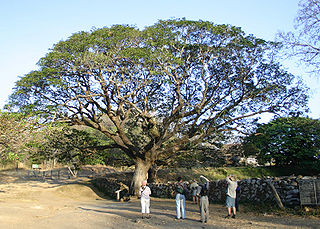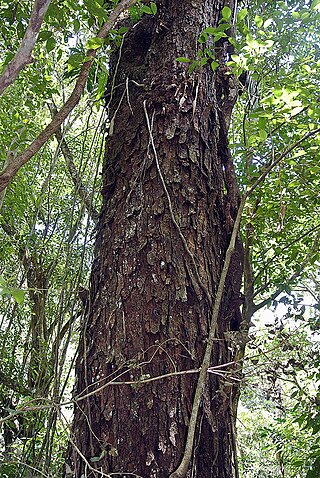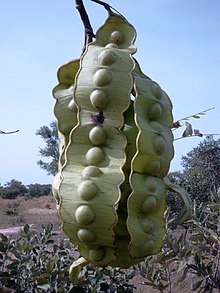
The Mimosoideae are a traditional subfamily of trees, herbs, lianas, and shrubs in the pea family (Fabaceae) that mostly grow in tropical and subtropical climates. They are typically characterized by having radially symmetric flowers, with petals that are twice divided (valvate) in bud and with numerous showy, prominent stamens.

Dalbergia is a large genus of small to medium-size trees, shrubs and lianas in the pea family, Fabaceae, subfamily Faboideae. It was recently assigned to the informal monophyletic Dalbergia clade : the Dalbergieae. The genus has a wide distribution, native to the tropical regions of Central and South America, Africa, Madagascar and southern Asia.

Bauhinia is a large genus of flowering plants in the subfamily Cercidoideae and tribe Bauhinieae, in the large flowering plant family Fabaceae, with a pantropical distribution. The genus was named after the Bauhin brothers Gaspard and Johann, Swiss-French botanists.

Mucuna is a genus of around 114 accepted species of climbing lianas (vines) and shrubs of the family Fabaceae: tribe Phaseoleae, typically found in tropical and subtropical forests in the Americas, sub-Saharan Africa, southern, southeastern, and eastern Asia, New Guinea, Australia, and the Pacific Islands.

The plant tribe Phaseoleae is one of the subdivisions of the legume subfamily Faboideae, in the unranked NPAAA clade. This group includes many of the beans cultivated for human and animal food, most importantly from the genera Glycine, Phaseolus, and Vigna.

Cynometra is genus of tropical forest trees with a pantropical distribution.

The subfamily Detarioideae is one of the subdivisions of the plant family Fabaceae (legumes). This subfamily includes many tropical trees, some of which are used for timber or have ecological importance. The subfamily consists of 84 genera, most of which are native to Africa and Asia. Pride of Burma and tamarind are two of the most notable species in Detarioideae. It has the following clade-based definition:
The most inclusive crown clade containing Goniorrhachis marginataTaub. and Aphanocalyx cynometroidesOliv., but not Cercis canadensisL., Duparquetia orchidaceaBaill., or Bobgunnia fistuloides(Harms) J. H. Kirkbr. & Wiersema.

Parkia is a genus of flowering plants in the family Fabaceae. It belongs to the mimosoid clade of the subfamily Caesalpinioideae. Several species are known as African locust bean.

Chamaecrista is a genus of flowering plants in the pea family, Fabaceae, subfamily Caesalpinioideae. Members of the genus are commonly known as sensitive pea. Several species are capable of rapid plant movement. Unlike the related genera Cassia and Senna, members of Chamaecrista form root nodules.

The genus, Pterolobium, consists of 10 species of perennial flowering plants in the family Fabaceae, subfamily Caesalpinioideae and tribe Caesalpinieae. They are sometimes called redwings and are native to the tropical to subtropical climes of Africa and Asia, including Indonesia and the Philippines. They are large scrambling or climbing shrubs that grow in riverside thickets, on rocky slopes or at forest margins. They bear colourful samara fruit, and have pairs of thorns below the rachis of their bipinnate leaves.

Samanea is a genus of flowering plants in the family Fabaceae. It includes four species of trees native to the tropical Americas, ranging from Belize to Paraguay, and to the Democratic Republic of the Congo in central Africa. Habitats include tropical moist evergreen and seasonally-dry deciduous forest, woodland, and wooded grassland. It belongs to the mimosoid clade of the subfamily Caesalpinioideae. The type species is Samanea saman from South America.

Senegalia is a genus of flowering plants in the family Fabaceae. It belongs to the Mimosoid clade. Until 2005, its species were considered members of Acacia. The genus was considered polyphyletic and required further division, with the genera Parasenegalia and Pseudosenegalia accepted soon after.

Parapiptadenia is a genus of flowering plants in the family Fabaceae. It includes six species of trees and shrubs native to eastern and southern Brazil, Bolivia, Paraguay, Uruguay, and northern Argentina. Typical habitats include tropical coastal and dune forest (restinga), woodland, scrub, and secondary growth forest. It belongs to the mimosoid clade of the subfamily Caesalpinioideae.

The tribe Dalbergieae is an early-branching clade within the flowering plant subfamily Faboideae. Within that subfamily, it belongs to an unranked clade called the dalbergioids. It was recently revised to include many genera formerly placed in tribes Adesmieae and Aeschynomeneae and to be included in a monophyletic group informally known as the dalbergioids sensu lato. The members of this tribe have a distinctive root nodule morphology, often referred to as an "aeschynomenoid" or "dalbergioid" nodule.

Phanera is a genus of flowering plants in the legume subfamily Cercidoideae and the tribe Bauhinieae. This genus differs from Bauhinia in being vines or lianas, generally with tendrils and a lobed rather than spathaceous calyx, and from Schnella in having only three fertile stamens rather than ten, and being native to the Indomalayan realm and the Australasian realm rather than the Americas. The subsection Corymbosae was recently segregated into a new genus, Cheniella. It has been suggested that the genus Lasiobema should be reduced to a section within Phanera.

The tribe Caesalpinieae is one of the subdivisions of the plant family Fabaceae: subfamily Caesalpinioideae.

Mezoneuron is a genus of flowering plants in the legume family, Fabaceae. It belongs to the subfamily Caesalpinioideae and the tribe Caesalpinieae.
Denisophytum is a genus of flowering plants in the family Fabaceae. It belongs to subfamily Caesalpinioideae and tribe Caesalpinieae. It includes eight species, which have a disjunct distribution – northern Mexico, Florida and the Caribbean, southern South America, the Horn of Africa, the Arabian Peninsula, and Madagascar.




















